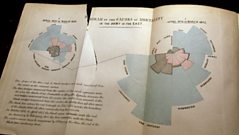
Florence Nightingale
The story behind Florence Nightingale's rose diagram, designed to persuade the government that lives could be saved with better sanitation in hospitals.
Series in which mathematician Marcus du Sautoy explores the stories behind some of the world's most familiar scientific diagrams.
Can a diagram save lives? Florence Nightingale is best known as the Lady of the Lamp, who cared for thousands of soldiers in appalling conditions during the Crimean War of 1854-6. What is less well-known is that she was a superb statistician, and the first to use a statistical graphic as a call to action.
After the war, Nightingale wrote a passionate report on why the soldiers had died in such large numbers and it revealed the astonishing fact that out of 18,000 deaths, 16,000 had been due to infectious diseases in hospital rather than battle wounds. The report included her revolutionary and controversial 'Rose Diagram', whose message was potent and direct - hospitals can kill. The diagram was designed to persuade the British government that, if sanitation in hospitals was improved, many deaths could be avoided. Nightingale's pioneering diagram was a catalyst in the creation of better and cleaner hospitals that would go on to save thousands of lives.
Last on
Clip
-
![]()
Florence Nightingale's rose diagram
Duration: 01:24
Credits
| Role | Contributor |
|---|---|
| Presenter | Marcus du Sautoy |
| Series Producer | Michael Waterhouse |
| Executive Producer | Harry Bell |

